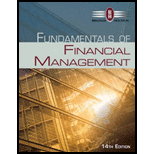
a.
To compute: The net operating working capital of Company B.
Financial Statements: A part of annual report that is attributed to the financials of the company for an accounting period is called financial statements. These include income statement, statement of
Net Operating Working Capital: The difference of current assets and current liabilities is called working capital. When only accounts payable and accruals are considered instead of total current liabilities, the difference is called net operating working capital.
a.
Answer to Problem 14P
The Company B has net operating working capital of $53,725 and $44,000 in 2015 and 2014, respectively
Explanation of Solution
Solution:
Given (for 2015),
Accounts payable are $10,800.
Accruals are $7,600.
Current assets are $72,125.
Formula to compute net operating working capital,
Substitute $10,800 for accounts payable, $7,600 for accruals and $72,125 for current assets.
Given (for 2014),
Accounts payable are $9,000.
Accruals are $6,000.
Current assets are $59,000.
Formula to compute net operating working capital,
Substitute $9,000 for accounts payable, $6,000 for accruals and $59,000 for current assets.
Therefore the Company B has net operating working capital of $53,725 and $44,000 in 2015 and 2014, respectively.
b.
To compute: The
Free Cash Flow: The cash generated over and above required by business operations and capital expenditure is called free cash flow. Statement of cash flow reports the cash flow generated or consumed by the business.
b.
Answer to Problem 14P
The free cash flow in 2015 for Company B is $11,175.
Explanation of Solution
Determine the capital expenditure
Therefore the capital expenditure is $8,000
Determine the free cash flow for 2015
Therefore the free cash flow in 2015 for Company B is $11,175.
c.
To prepare: The statement of
Statement of Stockholders’ Equity: Statement of stockholders’ equity shows the opening and closing balance of stockholder’s equity with the changes occurred during the accounting period.
c.
Answer to Problem 14P
Company B has stockholders’ equity of $82,025 at the end of year 2015.
Explanation of Solution
Statement of stockholders’ equity:
| Shares | Amount |
Retained Earnings |
Total Stockholders’ Equity | |
| Balances, December 31, 2014 | 5,000 | 50,000 | 20,850 | 70,850 |
| Net income, 2015 | 22,350 | |||
| Cash dividends | (11,175) | |||
| Additional to retained earnings | 11,175 | |||
| Balances, December 31, 2015 | 82,025 |
d.
To compute: The economic value added for Company B.
Economic Value Added (EVA): It is a measure along with market value added, to evaluate management’s performance. It considers the
d.
Answer to Problem 14P
The economic value added for Company B is $13,027.50.
Explanation of Solution
Given,
Net operating income is $39,000.
Income tax rate is 40%.
Total invested capital $103,725.
After tax percentage cost of capital is 10%.
Formula to compute economic value added,
Substitute $39,000 for operating income, 40% for tax rate, $97,025 for invested capital and 10% for after tax percentage cost of capital.
Therefore the economic value added for Company B is $13,027.50.
Working note:
Calculation of total invested capital,
e.
To compute: The market value added for Company B in 2015.
Market Value Added: The measure to evaluate management’s performance in a company’s operations and growth, market value added considers the market value of company’s outstanding shares. It reports the market value over and above the book value of those outstanding shares.
e.
Answer to Problem 14P
The market value added for Company B in 2015 is $17,975.
Explanation of Solution
Given,
Book value of common equity is $50,000.
Stock price is $20 per share.
Number of shares outstanding are 5,000.
Formula to compute market value added,
Substitute $50,000 for common book value of equity, $20 for stock price and 5,000 for number of shares outstanding.
Therefore the market value added for Company B in 2015 is $17,975.
Want to see more full solutions like this?
Chapter 3 Solutions
Fundamentals of Financial Management (MindTap Course List)
- Dear expert need help. What factors can lead to a high price-to-earnings (P/E) ratio?arrow_forwardWhat is the 50/30/20 budgeting rule in finance , and how is it applied?dont use chatarrow_forwardI need help in this question What is the weighted average cost of capital (WACC) and why is it important?arrow_forward
 EBK CONTEMPORARY FINANCIAL MANAGEMENTFinanceISBN:9781337514835Author:MOYERPublisher:CENGAGE LEARNING - CONSIGNMENT
EBK CONTEMPORARY FINANCIAL MANAGEMENTFinanceISBN:9781337514835Author:MOYERPublisher:CENGAGE LEARNING - CONSIGNMENT

